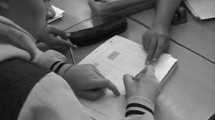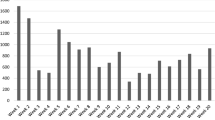Abstract
Utilizing video study methodology where participants, as well as the researcher, analyzed their own video data, this research examined the nature of students talking aloud during peer collaborations in mathematics. The findings suggest that students engage in three types of talking aloud: (1) clarification of thinking (i.e. spontaneous utterances related to the mathematical task); (2) expressions of confusion (i.e. “I don’t understand!”), with the explicit intent of eliciting support from peers; or (3) a combination of (1) and (2). The findings also show that students do not perceive other students’ talking aloud as an inter-communicative gesture. This research highlights the importance emphasizing to students that talking aloud during peer collaborations should be viewed as a potential antecedent to communicative interaction and the importance of teaching students how to listen to one another.
Similar content being viewed by others
References
Adler, J. (1999). The dilemma of transparency: Seeing and seeing through talk in the mathematics classroom. Journal for Research in Mathematics Education, 30(1), 47–64.
Ben-Yehuda, M., Lavy, I., Linchevski, L., & Sfard, A. (2005). Doing wrong with words: What bars students’ access to arithmetical discourses. Journal for Research in Mathematics Education, 36(3), 176–247.
Berger, M. (2004). The functional use of a mathematical sign. Educational Studies in Mathematics, 55, 81–102.
Burnett, P. C. (1999). Children’s self-talk and academic self-concepts: The impact of teachers’ statements. Educational Psychologist, 15(3), 195–200.
Chan, C. K. K. (2001). Peer collaboration and discourse patterns in learning from incompatible information. Instructional science, 29, 443–479.
Cohen, E. G. (1984). Talking and working together: Status, interaction, and learning. In P. L. Peterson, L. C. Wilkinson, & M. Hallinan (Eds.), The social context of instruction: Group organization and group processes (pp. 171–187). Orlando, FL: Academic Press.
Cohen, E. G. (1994). Restructuring the classroom: Conditions for productive small groups. Review of Educational Research, 64(1), 1–35.
Curcio, F. R., & Artzt, A. F. (1998). Students communicating in small groups: Making sense of data in graphical form. In H. Steinbring, M. G. Bartolini Bussi, & A. Sierpinska (Eds.), Language and communication in the mathematics classroom (pp. 179–190). Reston, VA: National Council of Teachers of Mathematics.
Daniels, H. (2001). Vygotsky and pedagogy. New York: Routledge/Falmer.
DeVries, R. (2000). Vygotsky, Piaget, and education: A reciprocal assimilation of theories and educational practices. New Ideas in Psychology, 18, 187–213.
Edwards, D., & Mercer, N. (1987). Common knowledge. London: Methuen & Co.
Erickson, F. (1986). Qualitative methods in research on teaching. In M. C. Witrock (Ed.), Handbook on research on teaching (3rd ed., pp. 119–161). New York: Macmillan.
Ericsson, K. A., & Simon, H. A. (1993). Protocol analysis: Verbal reports as data (2nd ed.). Boston: MIT Press.
Ericsson, K. A., & Simon, H. A. (1998). How to study thinking in everyday life: Contrasting think-aloud protocols with descriptions and explanations of thinking. Mind, Culture, and Activity, 5(3), 178–186.
Expert Panel on Student Success in Ontario (2004). Leading math success: Mathematical literacy grades 7–12. The report of the Expert Panel on Student Success in Ontario. Toronto, ON, Canada: Ontario Ministry of Education, Queen’s Printer for Ontario.
Glassman, M. (1994). All things being equal: The two roads of Piaget and Vygotsky. Developmental Review, 14, 186–214.
Glassman, M. (1995). The difference between Piaget and Vygotsky: A response to Duncan. Developmental Review, 15, 473–482.
Greenfield, L. B. (1987). Teaching thinking through problem solving. In J. E. Stice (Ed.), New directions for teaching and learning, no. 30. Developing critical thinking and problem solving (pp. 5–22). San Francisco: Jossey-Bass.
Gustafson, B. J., & MacDonald, D. (2004). Talk as a tool for thinking: Using professional discourse practices to frame children’s design technology talk. Canadian Journal of Science, Mathematics and Technology Education, 4(3), 331–351.
Hiebert, J., Gallimore, R., Garneir, H., Bogard Givvin, K., Hollingsworth, H., Jacobs, J., et al. (2004). Teaching mathematics in seven countries: Results from the TIMSS 1999 video study (NCES 2003-13 revised). Washington, DC: U.S. Department of Education, National Center for Education Statistics.
Johnson, S. D., & Chung, S-p. (1999). The effect of thinking aloud pair problem solving (TAPPS) on the troubleshooting ability of aviation technician students. Journal of Industrial Teacher Education, 37(1), 7–25.
Johnson, D. W., & Johnson, R. T. (1989). Cooperation and competition: Theory and research. Edina, MI: Interaction Book.
Johnson, D. W., & Johnson, R. T. (1992). Creative controversy: Intellectual challenge in the classroom. Edina, MI: Interaction Book.
Johnson, D. W., & Johnson, R. T. (1994). Learning together and alone: Cooperative, competitive, individualistic learning. Boston: Allyn & Bacon.
Klibanoff, R. S., Levine, S. C., Huttenlocher, J., Vasilyeva, M., & Hedges, L. V. (2006). Preschool children’s mathematical knowledge: The effect of teacher “math talk”. Developmental Psychology, 42(1), 59–69.
Kotsopoulos, D. (2007). Communication in mathematics: A discourse analysis of peer collaborations (Unpublished doctoral dissertation). The University of Western Ontario, London, ON, Canada.
Kotsopoulos, D. (2008). Beyond teachers’ sight lines: Using video modeling to examine peer discourse. Mathematics Teacher, 101(6), 468–472.
Lochhead, J., & Whimbey, A. (1987). Teaching analytical reasoning through thinking aloud pair problem solving. In J. E. Stice (Ed.), New directions for teaching and learning, no 30. Developing critical thinking and problem solving abilities (pp. 73–92). San Francisco: Jossey-Bass.
Mercer, N. (1996). The quality of talk in children’s collaborative activity in the classroom. Learning and Instruction, 6(4), 359–377.
Mercer, N., Wegerif, R., & Dawes, L. (1999). Children’s talk and the development of reasoning in the classroom. British Educational Research Journal, 25(1), 95–111.
Monaghan, F. (2006). Thinking aloud together. Mathematics Teaching, 198, 12–15.
Moschkovich, J. (2003). What counts as mathematical discourse? In N. A. Pateman, B. J. Dougherty, & J. Zilliox (Eds.), Proceedings of the Joint meeting of PME and PMENA(Vol. 3, pp. 325–331). Honolulu, Hawai’i, USA: University of Hawai’i.
National Council of Teachers of Mathematics/NCTM (2000). Principles and standards for school mathematics. Reston, VA: Author.
Ontario Ministry of Education and Training/OMET (2005). The Ontario curriculum Grades 1–8 mathematics, revised. Toronto, ON, Canada: Queen’s Printer for Ontario.
Piaget, J. (1962). Comments on Vygotsky’s critical remarks. Cambridge, MA: MIT.
Piaget, J. (2002). Language and thought of the child (M. Gabain & R. Gabain, Trans) (3rd ed.). London: Routledge.
Pimm, D. (1987). Speaking mathematically: Communication in mathematics classrooms. New York: Routledge & Kegan Paul.
Pirie, S. E. B. (1998). Crossing the gulf between thought and symbol: Language as (slippery) stepping-stones. In H. Steinbring, M. G. Bartolini Bussi, & A. Sierpinska (Eds.), Language and communication in the mathematics classroom (pp. 7–29). Reston, VA: National Council of Teachers of Mathematics.
Richards, J. (1991). Mathematical discussions. In E. von Glasersfeld (Ed.), Radical constructivism in mathematics education (pp. 13–51). Dordrecht, The Netherlands: Kluwer Academic.
Rowland, T. (1999). Pronouns in mathematics talk: Power, vagueness and generalisation. For the Learning of Mathematics, 19(2), 19–26.
Setati, M. (2003). Language use in a multilingual mathematics classroom in South Africa: A different perspective. Paper presented at the 2003 Joint Meeting of PME and PME-NA, Honolulu, USA.
Sfard, A., & Kieran, C. (2001). Cognition as communication: Rethinking learning-by-talking through multi-faceted analysis of students’ mathematical interactions. Mind, Culture, and Activity, 8(1), 42–76.
Sfard, A., Nesher, P., Streefland, L., Cobb, P., & Mason, J. (1998). Learning mathematics through conversation: Is it as good as they say? [1]. For the Learning of Mathematics, 18(1), 41–51.
Short, E. J., Schatschneider, C., Cuddy, C. L., Evans, S. W., Dellick, D. M., & Basili, L. A. (1991). The effect of thinking aloud on the problem-solving performance of bright, average, learning disabled, and developmentally handicapped students. Contemporary Educational Psychology, 16, 139–153.
Sinclair, M. P. (2005). Peer interactions in a computer lab: Reflections on results of a case study involving web-based dynamic geometry sketches. Journal of Mathematical Behavior, 24, 89–107.
Sleeter, C. E. (2001). Epistemological diversity in research on preservice teacher preparation for historically underserved children. In W. G. Secada (Ed.), Review of research in education 25, 2000–2001 (pp. 209–250). Washington, DC: American Educational Research Association.
Stice, J. E. (Ed.). (1987). New directions for teaching and learning, no. 30. Developing critical thinking and problem-solving abilities. San Francisco: Jossey-Bass.
van der Veer, R., & Valsiner, J. (1994). The Vygotsky reader. Oxford, UK: Blackwell.
Vygotsky, L. S. (1962). Thought and language. Cambridge, MA: MIT Press.
Vygotsky, L. S. (1978). Mind in society. Cambridge, MA: Harvard University Press.
Zolkower, B., & Shreyar, S. (2007). A teacher’s medication of thinking-aloud discussion in a 6th grade classroom. Educational Studies in Mathematics, 65, 177–202.
Author information
Authors and Affiliations
Corresponding author
Rights and permissions
About this article
Cite this article
Kotsopoulos, D. AN ANALYSIS OF TALKING ALOUD DURING PEER COLLABORATIONS IN MATHEMATICS. Int J of Sci and Math Educ 8, 1049–1070 (2010). https://doi.org/10.1007/s10763-010-9221-8
Received:
Accepted:
Published:
Issue Date:
DOI: https://doi.org/10.1007/s10763-010-9221-8




